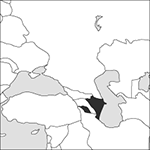
Capital:
Baku
Area:
86,600 sq km (33,430 sq miles)
Population:
9,493,600 (2012 est)
Currency:
1 manat = 100 gopik
Religions:
Muslim 93.4%; Eastern Orthodox 4.8%
Ethnic Groups:
Azeri 90.3%; Lezgian 2.0%; Russian 1.3%; Armenian 1.3%; Talysh 1.3%
Languages:
Azeri Turkish (official); Armenian, Russian, and other minority languages
International Organizations:
UN; Commonwealth of Independent States; OSCE; Euro‐Atlantic Partnership Council; Council of Europe; Non‐Aligned Movement
A country in western Asia, in the Caucasus. Situated on the west coast of the Caspian Sea, Azerbaijan is bordered by Armenia to the west, Georgia and Russia to the north, and Iraq to the south.
Physical
The Apsheron Peninsula in the north contains the long‐established Baku oilfields. The hot and arid Kura valley runs towards the south‐east below the Caucasian foothills. The Caspian coastal plain with a subtropical climate is more naturally fertile; round it lie well‐wooded hills with deep valleys. The mountainous south‐west contains the large and scenic Lake Gyoygyol as well as numerous deposits of copper, iron, and lead.
Economy
Azerbaijan was the world’s leader in petroleum production at the beginning of the 20th century, and oil and gas still provide around 90% of exports. Other industries include manufacturing and chemicals. Agriculture provides 40% of employment, with products including cotton and food crops; viticulture is also important.
History
The country comprises the part of the Azerbaijan area that was conquered by Russia in the 18th and 19th centuries (the remainder of the traditional Azerbaijan area is now incorporated in Iran). By 1914 it was the largest oil‐producing area in the world, centred on Baku. After the Bolshevik Revolution in Russia of 1917, it declared its independence, but in 1920 was conquered by the Red Army. The Azerbaijan Soviet Socialist Republic was created, which in 1922 was linked with Armenia and Georgia as the Transcaucasian Soviet Federated Socialist Republic. This split in 1936 into three separate republics as members of the Soviet Union. The autonomous region of Nakhichevan formed an exclave within Armenia, while a second area, that of Nagorno Karabakh, inhabited by Christian Armenians and claimed by Armenia, lay within the Republic. Severe violence erupted over the latter, with military intervention by the Soviet Union in 1989. In 1991 Azerbaijan declared its independence, as a Shi’ite Muslim state, and the Nakhichevan region declared its own independence in 1992. Fighting in Nagorno Karabakh and Nakhichevan has continued sporadically, despite several ceasefire agreements. Nagorno Karabakh declared itself to be independent in 1996. In 1993 President Elchibey was ousted in a military coup; President Heydar Aliyev took over, his position being ratified in elections. Parliamentary elections in 1995 were won by Aliyev’s party and he was re‐elected in 1998 amidst violent protests and allegations of fraud. He was succeeded by his son, Ilham Aliyev, at the 2003 presidential elections. Ilham was re-elected in 2008 and in 2009 he pushed through a constitutional amendment that removed presidential term limits. He was re-elected in 2013 and retained control of parliament in the 2015 election.
- dialectical materialism
- dialectical school
- dialectical theology
- dialectics
- dialetheia
- dialetheism
- diallage
- diallelus
- dialler
- dialler program
- dialogue box
- dialogue management
- dial-up access
- dial-up line
- dial-up networking
- dialysis
- diamagnetism
- Diamant rocket
- diameter
- diameter(of a graph)
- diameter of a set(metric space)
- diametrical voltage
- diamict
- diamictite
- diamicton